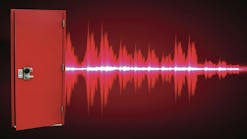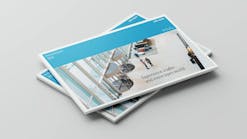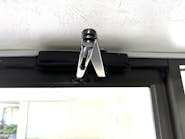What's New With Exit Devices? K2 Commercial Hardware Enters The Market
The exit device, also known as a panic device, was first introduced in 1908 by Carl Prinzler & Henry DuPont in response to a devastating fire in Chicago 's Iroquois Theatre in 1903 where 594 people perished because the doors of the day did not provide free egress.
The exit device is a type of “free egress” door lock having an inside release bar mechanism, which is the actuating portion of the locking mechanism. No prior knowledge of operation is needed to open the door. Mounted onto the inside of an outswinging door, this activating portion can be known as the crash bar, crossbar, push bar or push pad. The term crash bar was probably evolved when panicking people first “crashed” into the bar, opening the door and lived to tell of their escape. What makes the exit device unique is that it provides life safety through free and easy egress, while still maintaining the security of the building.
Exit devices are divided into two categories: “panic hardware” and “fire exit hardware.” Fire exit hardware is almost identical to panic hardware and operates in the same manner. However, it possesses some important differences.
Fire Exit Hardware has been designed, tested and approved by UL for operation on a fire rated openings which are also called “Labeled” openings. The fire exit device includes fire rated components designed to withstand high temperatures up to three hours, ensuring that the door stays latched during a fire which helps compartmentalize and control the spreading of smoke and flames. The latchbolt must always be active to ensure positive latching; therefore a fire exit device can never have mechanical dogging capability.
Both fire exit hardware and panic hardware must have an actual label visible on the product after installation, signifying that it is either a “Panic Device” or “Fire Exit Hardware.” Typically this label is located on the side of the head cap. That is the only positive way to identify the type of device installed on an opening.
The exit/panic device contains a dogging mechanism, which allows devices in high traffic applications to have the bar/pad locked down, so the latch bolt remains retracted. This permits the door to be opened without the exit device latching mechanism operating and limits wear and tear on the device, extending its life. With the latch dogged (retracted), and a dummy handle or pull on the exterior of the door, people can gain both access and egress through the opening. A typical application for this would be a store front or mall entrance during business hours. Dogging mechanisms include hex or similar wrench type keys, mechanical lock cylinders or electrically operated bar/latch retraction.
Exit devices can be either “Exit Only” (no exterior trim) or be outfitted with an exterior trim in different configurations and functions. Exterior trims vary in design and look from a pull or thumbpiece , to a key in lever with a rose, or a lever with an escutcheon plate. Typical trim functions available include dummy, passage, classroom, and storeroom (also known as a nightlatch ). Most exit devices will use a standard mortise or rim cylinder and can be keyed to match existing mechanical key systems.
K2 Commercial Hardware exit devices are designed to provide free egress while restricting access through the use of keyed trim options. The K2 exit devices meet or exceed ANSI A156.3 Series Grade 1 requirements.
The QED100 Series is a heavy duty institutional type Grade 1 exit device that has exceeded the 500,000 cycles by more than double. The QED300 Series is a utility type Grade 1 exit device that has exceeded the 500,000 cycles. The QED100 and QED300 Series exit devices are UL10C/UBC 7-2 (1997) Positive Pressure Rated, UL10B Pressure Rated and UL305 for panic hardware. The K2 exit devices are Americans with Disabilities Act compliant and California State Reference Code compliant.
The QED100 and QED300 exit devices are available as rim devices or surface vertical rod devices that accommodate a 36-inch wide door and are easily field sizable down to a 32-inch door. Both the rim and surface vertical rod exit devices are available in fire-rated and panic versions. Their devices can be ordered with either hex key or cylinder dogging. In addition, the surface vertical rod exit devices are available less bottom rod with dogging options.
The K2 exit devices are available fire rated. The QED100 Series exit devices have a three hour “A” label. The QED300 Series surface vertical rod exit devices have a 1-1/2 hour “B” label. The QED300 Series rim exit devices have a three hour “A” label. These fire rated rim devices accommodate a single door up to 4 feet by 8 feet. The fire rated surface vertical rod exit devices accommodate up to an 8-foot by 8-foot pair of doors.
The institutional type Grade 1 models, the QED100 Series exit devices are manufactured of extruded aluminum and have a double plated head. The head assemblies are manufactured of two steel plates for added strength and reinforcement. The utility type Grade 1 models, the QED300 Series exit devices, are manufactured of steel with a single plate head assembly.
The QED100 Series is equipped with the push pad stabilizing mechanism. This mechanism incorporates a unique shaped “L” bracket within the roller assembly attached between two parallel plates on the push pad, keeping the push pad in constant contact with the device rail. The roller assembly smooths and helps to silence the compression and the expansion of the push pad. According to K2 , “there is a significant noise reduction and the push pad remains quiet even when struck with force.”
The QED100 Series exit devices are non-handed. The 36-inch exit device is adjustable to a 32-inch wide opening. The push pad is 24 inches , large enough to satisfy code requirements for a 48-inch wide opening (Code requires the push pad to cover at least 50 percent of the door width). The QED100 Series push pad is serviceable with replacement parts available. The QED300 Series push pad mechanisms are not serviceable.
Both the QED100 & QED300 Series exit devices are designed to retrofit over existing 161 door prep, and no modification is needed to the exit device to accept any of the trims available. The head unit and the bar are large enough to cover the 2-1/8” diameter cross bore opening at 2-3/4” backset. The exit device head cap and end cap are manufactured of zinc die-cast.
The K2 rim exit device is surface mounted. The latch bolt projects from the center of the center case. The QED100 Series one-inch wide stainless steel latchbolt has a ¾-inch projection. The QED300 Series .86-inch wide cast steel latch bolt has a ¾-inch projection. The latchbolts have a dead latch for added security. Fire rated devices are equipped with a fusible link that locks the latch in the latched position.
The K2 surface vertical rod exit device is designed to accommodate a seven foot door height. Eight foot rods are optional. The QED100 Series surface vertical rod device's seven- and eight-foot rods are one piece versus two piece rods on the QED300 Series. In addition, the QED100 Series vertical rods are fully enclosed within a decorative extruded aluminum cover. The QED100 Series latchbolts ' top and bottom are stainless steel with a ½- inch throw . The QED300 Series latchbolts are ½-inch top and 3/8-inch bottom.
The QED100 Series exit devices are available in Bright Brass 605, Satin Chrome 626, and Anodized statuary Bronze 613 finishes.
The QED300 Series exit devices are available in painted finishes 689 - Aluminum and 690 - Bronze.
The K2 Commercial Hardware QED100 and QED300 exit devices have a limited lifetime mechanical warranty and a three-year finish* warranty. (*613/US10B carries no finish warranty.)
For more information, contact your local locksmith wholesaler or K2 Commercial Hardware, 19701 Da Vinci, Lake Forest , CA. 92610. Telephone: 866-590-2094. Fax: 866-493-4737. Web Site: www.K2commercialhardware.com.
John McPartland is commercial hardware development manager for K2 Commercial Hardware by Black & Decker. McPartland joined Black & Decker in 2005 as part of a team to develop the K2 brand. He has over 21 years of business management and sales experience and nine years of experience in commercial and residential hardware. He is an active member of DHI.





